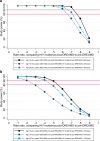Evaluating the impact of the DREAMS partnership to reduce HIV incidence among adolescent girls and young women in four settings: a study protocol
- PMID: 30045711
- PMCID: PMC6060450
- DOI: 10.1186/s12889-018-5789-7
Evaluating the impact of the DREAMS partnership to reduce HIV incidence among adolescent girls and young women in four settings: a study protocol
Abstract
Background: HIV risk remains unacceptably high among adolescent girls and young women (AGYW) in southern and eastern Africa, reflecting structural and social inequities that drive new infections. In 2015, PEPFAR (the United States President's Emergency Plan for AIDS Relief) with private-sector partners launched the DREAMS Partnership, an ambitious package of interventions in 10 sub-Saharan African countries. DREAMS aims to reduce HIV incidence by 40% among AGYW over two years by addressing multiple causes of AGYW vulnerability. This protocol outlines an impact evaluation of DREAMS in four settings.
Methods: To achieve an impact evaluation that is credible and timely, we describe a mix of methods that build on longitudinal data available in existing surveillance sites prior to DREAMS roll-out. In three long-running surveillance sites (in rural and urban Kenya and rural South Africa), the evaluation will measure: (1) population-level changes over time in HIV incidence and socio-economic, behavioural and health outcomes among AGYW and young men (before, during, after DREAMS); and (2) causal pathways linking uptake of DREAMS interventions to 'mediators' of change such as empowerment, through to behavioural and health outcomes, using nested cohort studies with samples of ~ 1000-1500 AGYW selected randomly from the general population and followed for two years. In Zimbabwe, where DREAMS includes an offer of pre-exposure HIV prophylaxis (PrEP), cohorts of young women who sell sex will be followed for two years to measure the impact of 'DREAMS+PrEP' on HIV incidence among young women at highest risk of HIV. In all four settings, process evaluation and qualitative studies will monitor the delivery and context of DREAMS implementation. The primary evaluation outcome is HIV incidence, and secondary outcomes include indicators of sexual behavior change, and social and biological protection.
Discussion: DREAMS is, to date, the most ambitious effort to scale-up combinations or 'packages' of multi-sectoral interventions for HIV prevention. Evidence of its effectiveness in reducing HIV incidence among AGYW, and demonstrating which aspects of the lives of AGYW were changed, will offer valuable lessons for replication.
Keywords: Adolescent health; Complex intervention; Gender equity; HIV prevention; Impact evaluation; Kenya; South Africa; Zimbabwe.
Conflict of interest statement
Ethics approval and consent to participate
The study protocol, including informed consent and study tools, has been reviewed and approved by the Observational Research Ethics Committee of the London School of Hygiene and Tropical Medicine, and committees in each of the host countries, specifically: KEMRI (Gem, Kenya); Amref Health Africa in Kenya (Nairobi, Kenya); University of KwaZulu-Natal Biomedical Research Ethics Committee (South Africa); and Medical Research Council of Zimbabwe, and the Liverpool School of Tropical Medicine. Participants will be asked for their informed, written consent to participate in all aspects of the study, as will parents/guardians of legal minors under age 18 years.
Consent for publication
Not applicable.
Competing interests
The authors declare that they have no competing interests.
Publisher’s Note
Springer Nature remains neutral with regard to jurisdictional claims in published maps and institutional affiliations.
Figures



References
-
- UNAIDS . Prevention gap report. 2016.
-
- UNAIDS, 2016. All in to end the adolescent AIDS epidemic: A progress report. http://www.unaids.org/sites/default/files/media_asset/ALLIN2016ProgressR...
-
- United Nations, 2012. World Population Monitoring: Adolescents and Youth. United Nations Department of Economic and Social Affairs, Population Division.
-
- Mavedzenge SN, Luecke E, Ross DA. Effective approaches for programming to reduce adolescent vulnerability to HIV infection, HIV risk, and HIV-related morbidity and mortality: a systematic review of systematic reviews. J Acquir Immune Defic Syndr. 2014;66(Suppl 2):S154–S169. doi: 10.1097/QAI.0000000000000178. - DOI - PubMed
-
- Bundy DAP, de Silva N, Horton S, Patton GC, Schultz L, Jamison DT. Disease control priorities C, adolescent H, development authors G: investment in child and adolescent health and development: key messages from disease control priorities, 3rd edition. Lancet. 2018;391(10121):687–699. doi: 10.1016/S0140-6736(17)32417-0. - DOI - PubMed
Publication types
MeSH terms
Grants and funding
LinkOut - more resources
Full Text Sources
Other Literature Sources
Medical
Miscellaneous

